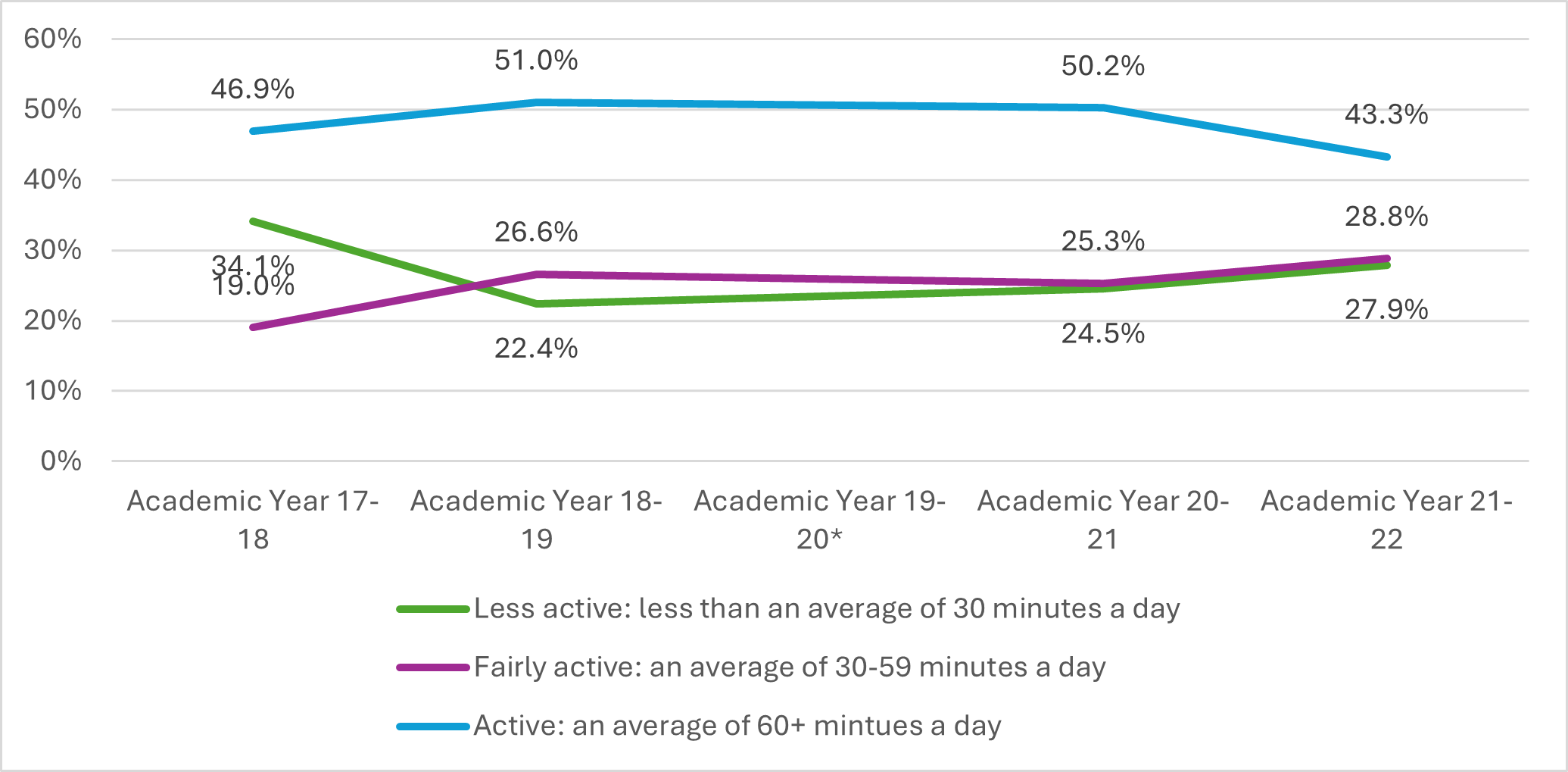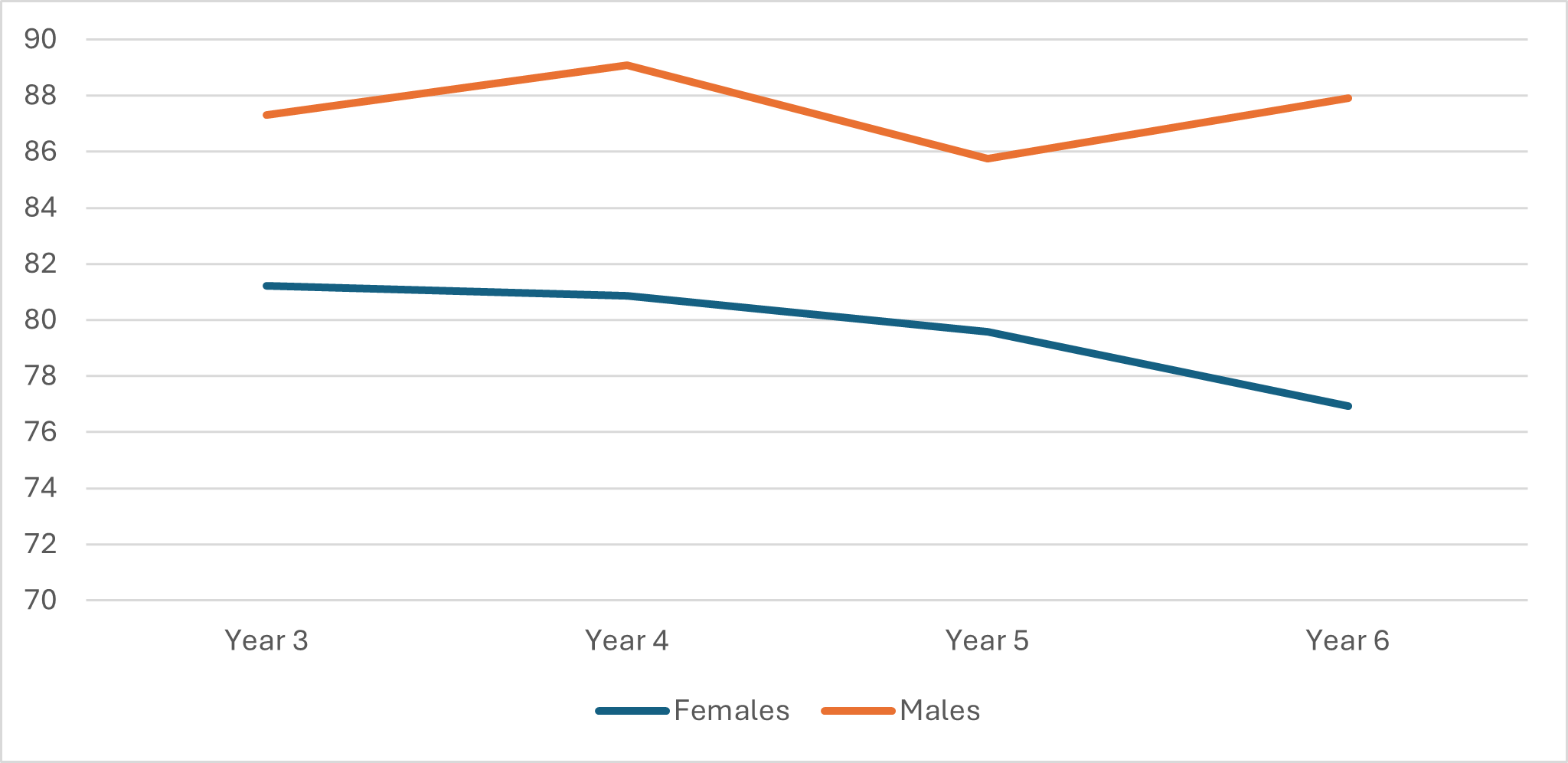Get Cheshire West Moving
Where are we now?
0-19 Being Active Joint Strategic Needs Assessment (JSNA) Summary
The 0-19 Being Active JSNA was published in February 2024 as part of a series of nine chapters assessing the current and future health and social care needs of children and young people aged 0 to 19 (25 with SEND) and their families, with a focus on improving the health and wellbeing and reducing inequalities.
This chapter reviewed physical activity across the early years, in educational settings, community settings, active travel and being active at home. The findings highlight that in recent years physical activity for many children and young people has moved from unstructured to structured physical activity, meaning the majority of physical activity is carried out as part of PE in school or at sports clubs rather than more unstructured activities such as playing football or tag in the park, or travelling actively.
The 0-19 Being Active JSNA identifies a decline in participation of physical activity as children reach adolescence and beyond, particularly for girls. As well as this, data suggests that as children and young people grow, there are changes in the types of activities they want to take part in - understanding and adapting to this is key to increasing engagement and participation.
There is a clear role for early years and educational establishments. From a very young age, children need to develop fundamental movement skills and the social skills which many activities require, whether that is part of a structured sporting activity or playing a team sport during school breaks or after school.
School provides an excellent opportunity to try new activities, a focus on finding ways to increase physical activity for all pupils, regardless of skill, interest or motivation can make a big difference.
There is an important role for parents and carers in both supporting their children’s movement and activity and also positive role modelling. Many children and young people need encouragement and support to be active, particularly when taking part in sports and other activities outside school.
Of course, having activities which children and young people can take part in outside school is also vital which is where the leisure providers, community organisations and the local authority come in. What is clear is that a joined-up system-wide approach is essential to increase the physical activity levels of our children and young people.
The 0-19 Being Active JSNA utilised data from a number of sources, including the Children and Young Person Active Lives Survey and the local Koboca Pupil Survey. A selection of charts is displayed below, but a more detailed picture can be found in the published 0-19 Being Active JSNA document.
For Cheshire West and Chester, the Children and Young Person Active Lives Survey (January 2023 – academic year 2021-22), suggests that 43.3% of children (age 5-16 years) in Cheshire West and Chester were meeting the UK Chief Medical Officers' (CMOs') recommendation that children and young people (5 to 18 years) are physically active for an average of at least 60 minutes per day across the week (see Chart 1). Since the 2018-19 academic year, there has been a decrease in the proportion of children (aged 5-16) who are meeting CMO recommendation of 60+ minutes a day of activity, however, since the 20/21 academic year the proportion of children who are fairly active has increased.
Cheshire West and Chester, 0-19 Being Active Joint Strategic Needs Assessment. Available at: Joint Strategic Needs Assessment (JSNA) | Cheshire West and Chester Council
Chart 1: Levels of activity for Children and Young People in Cheshire West and Chester over time


Source: Active Live (Children and Young People), Sport England, 2022
Chart 2 is data for Key Stage 2 children (age seven to 11). The chart presents the percentage of children who ‘feel good’ when taking part in PE, physical activity and/or sport across the year groups and split by sex. The chart shows that more males said they ‘feel good’ when taking part in PE, physical activity and/or sport’ than females for all year groups.
Chart 2: Percentage of Key Stage 2 children who feel good when they take part in PE, physical activity and/or sport, split by sex and year group


Source: Koboca Survey (local data)
Chart 3 shows data for young people in school years 7, 8 and 9 (age 11 – 14 years) split across levels of activity and split by sex. The chart shows similar figures for males and females for the ‘not active’ and ‘active’ categories. With more females reporting being ‘semi-active’ across the year groups, and more males reporting being ‘very active’ across the year groups.
Chart 3: Activity levels for Key Stage 3 (year groups 7-9 children) split by sex


Source: Koboca Survey (local data)
When children in year groups 7-9 (ages 11-14 years) were asked ‘When you take part in PE what do you enjoy the most?’, the most common responses were ‘being with friends’ and ‘having fun’ for both males and females, with the females placing ‘being with friends’ as what they enjoyed the most, whilst males responded that ‘having fun’ was the most important factor for them. The results are shown in chart 4.
Chart 4: Reasons provided for why Key Stage 3 children enjoy PE, split by sex


Source: Koboca Survey (local data)
There are many opportunities for younger residents of Cheshire West and Chester to be active both in informal and formal settings, however barriers exist. These include:
- Findings from the ActiveCHILD study provide insight into both activity levels of children and young people in the early years, plus the actions that parents and carers take to support their child’s activity levels. The research findings show that some parents and carers choose for the family to stay at home rather than go out, impacting on the level of activity the child is able to take part in. This highlights the role of the parent/ carer in the child being active.
- Research as part of the Active 6 Project, found that children’s activity is now dependent on more structured activities, such as active clubs, and less dependent on unstructured activities, such as playing with friends after school. This is important for schools and other settings to understand and consider when organising school-based and extra-curricular activities.
- With Cheshire West and Chester being a large geographical area, it is not possible for all residents to be able to access a leisure facility easily. As part of their development model, Brio Leisure launched a hub and spoke offer, taking activities to communities who are less well served by the leisure facilities (due to distance, transport etc.), ensuring that children and young people are considered within the offer and taking a family approach to activities where possible.
Adult Physical Activity Needs Assessment summary
To inform the co-development of the Get Cheshire West Moving Strategy and complement the 0-19 Being Active JSNA, partners across the borough worked together to produce an Adult Physical Activity Needs Assessment.
Data and insight
|
National Data |
Local Partner Data |
Local Insight |
|---|---|---|
|
Active Lives Data 2021 Census
|
Brio membership and usage data Nature-based Wellbeing Cheshire’s Natural Health Service (Mersey Forest) Cheshire Football Association registered players Parkrun participation |
CW&C Adult Physical Activity and Movement Survey Fairer Futures Ambassador Focus Group (lived experience) Supporting Women and Girls to be active Workshop Sport Facilities Strategy and Playing Pitch Strategy |
Key findings
- More adults are physically active compared to North West and England average.
- Less adults are inactive compared to North West and England average.
- Women are less active than men.
- People living with a disability are less active than those without.
- Higher deprivation correlates with higher inactivity.
- The 35-44 age group are the least active.
- More than half of working age residents are sedentary for ≥ 6 hours per day on working days.
- Barriers to being active include ‘lack of time’, ‘lack of energy’, ‘cost and not being able to afford to pay for activities’, ‘health issues’.
- Far more females cite ‘lack of confidence’ as a barrier to being active than males.
- More males than females reported doing ‘as many activities at they wanted to’.
- Roads and streets were the most frequently used place to be active by survey respondents, followed by garden, the gym and woodlands.
- Parks and greenspaces were used by many people but less regularly.
- Males use almost all of the available assets and spaces more than females, the exception is community halls which are used by a higher percentage of females.
- ‘More free/affordable activities’, ‘local walking, wheeling, or cycling’, ‘local activities’ ‘better availability or timing of activities,’ ‘someone to be active with’ and ‘improved lighting in parks or open spaces’ would support more people to be active.
- Walking, yoga, Pilates, swimming, classes e.g. spinning, Zumba, gym, dancing and cycling.
- More males were interested in cycling, sports such as football, netball, and cricket, and running than females.
- More females were interested in dancing, swimming, yoga and classes e.g. Zumba, than males.
- Brio attracts membership from more females than males.
- Working age members make up the majority of Brio membership across all types (full, Pay as You Go, WorkFit).
- Nature-based activities are positive for engaging residents in activity and can have a positive impact on wellbeing.
- There are considerably more male adult players registered with Cheshire Football Association than females. Membership numbers decline with age.
- Parkruns across the borough engage over 1,000 residents each week.
- Walking or wheeling is a popular way to be active for all, regardless of age and sex.
- The majority of respondents stated that they do not cycle. More males than females do cycle and more frequently.
- In Cheshire West and Chester, a smaller proportion of working age residents walk or wheel to work than the England average. Fewer residents cycle to work compared to the England average, but more than the North West average.
- The CW&C Physical Activity and Movement Survey was not representative - 75% were female, the majority were aged 35-64, and considered themselves White British, and most were educated to a high level (had at least an undergraduate degree).
- The survey did not collect information on disability and could not be analysed by geography.
- We only received data from a small number of partners.
- There was limited use of the focus group template, despite partners stating that they would carry these out.
- Limited local insight in terms of disability and other inclusion groups.

